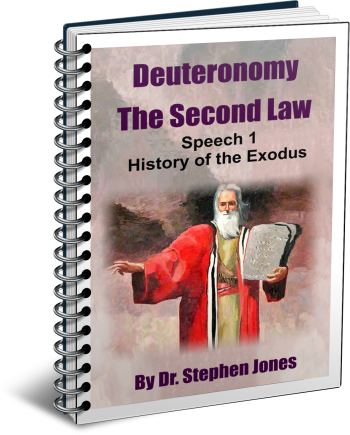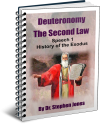Latest Posts
View the latest posts in an easy-to-read list format, with filtering options.

A commentary on the first speech of Moses in Deuteronomy 1-4. The book of Deuteronomy is a series of 12 speeches that Moses gave just before his death at the end of Israel's wilderness journey.
Category - Bible Commentaries

The defeat of Sihon gave Israel the land of Gilead, which was the mountains overlooking the Jordan River from the east. Its southern border was the Arnon River, where Moab's territory began. Its northern border was
Bashan, now known as the Golan Heights, not far from Damascus.
The king of Bashan was the next king to feel threatened. Not knowing the law of God, he assumed that Israel would attack Bashan without cause, so he launched a preemptive strike. Deut. 3:1-4 says,
1 Then we turned and went up the road to Bashan, and Og, king of Bashan, with all his people came out to meet us in battle at Edrei. 2 But the Lord said to me, “Do not fear him, for I have delivered him and all his people and his land into your hand; and you shall do to him just as you did to Sihon king of the Amorites, who lived at Heshbon.” 3 So the Lord our God delivered Og also, king of Bashan, with all his people into our hand, and we smote them until no survivor was left. 4 And we captured all his cities at that time; there was not a city which we did not take from them: sixty cities, all the region of Argob, the kingdom of Og in Bashan.
God's purpose in causing Og of Bashan to make war on Israel was to destroy the giants (Rephaim). Deut. 3:11 appears to be another notation from Ezra, telling us,
11 (For only Og king of Bashan was left of the remnant of the Rephaim. Behold, his bedstead was an iron bedstead; it is in Rabbah of the sons of Ammon. Its length was nine cubits and its width four cubits by ordinary cubit.
Ferrar Fenton translates this verse:
11 Og, king of Bashan was of the remnant of the race of the Rephaim. He can be seen lying upon a couch of iron which is preserved in Rabath of the Ammonites. Its length is nine cubits, and breadth four cubits, by the common cubit.
Fenton believed that this was a notation from Ezra, who was telling his readers that the embalmed body of Og had been placed in an Ammonite memorial, a museum or shrine of sorts). It could still be visited in his day after the Babylonian captivity of Judah. He lay on a bed that was nine common cubits, or about 13½ feet long.
If this bed had been measured in sacred cubits, called the “cubit of the sanctuary,” or the “great cubit,” it would have been an extra handbreadth in length (Ezekiel 43:13). In that case, the bed would have measured about 15 feet in length. Yet Ezra is careful to give us the precise measure in common cubits. The length of the bed suggests that Og of Bashan was 10 or 11 feet tall.
Canaan and the surrounding areas seemed to be full of Rephaim, Nephilim, Anakim, and other descendants of the unlawful marriages of Genesis 6:4. Because God vowed not to destroy them by a flood (Gen. 9:11), He used Israel to bring judgment upon them. Even so, some escaped divine judgment, including the family of Goliath who remained among the Philistines even centuries later.
So Israel destroyed their main cities, sixty of them. These did not include the small towns, for Deut. 3:5 says,
5 All these were cities fortified with high walls, gates, and bars, besides a great many unwalled towns.
In other words, there was a large population, and the record implies that they had intermarried with the Rephaim for many centuries. Hence, it is likely that virtually all of them by this time could trace some descent from these Rephaim.
Joshua 13:12 calls Og “the last of the Rephaites,” (NIV), but this does not mean the last of the giants, for there were other giant tribes, such as the Anakim, the tribe of Goliath. For some reason, all or many of these tribes seemed to live in the general vicinity of Mount Hermon.
The reason for this will be explained in the next chapter.
Perhaps the giants were aware that this land had an important role in the divine plan and that the Messiah would eventually be born there. Their occupation of Canaan may have been an attempt to thwart the divine plan.
6 And we utterly destroyed them, as we did to Sihon king of Heshbon, utterly destroying the men, women and children of every city. 7 But all the animals and the spoil of the cities we took as our booty.
Apparently, they had not learned to do genetic modifications on animals, and so they were given to the Israelites.
8 Thus we took the land at that time from the hand of the two kings of the Amorites who were beyond the Jordan, from the valley of Arnon to Mount Hermon.
This largely completed the conquest of the land east of the Jordan River. Ezra then inserts a short parenthetical statement that gives us a very important clue as to the importance of Mount Hermon in prophecy.